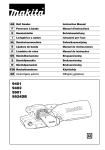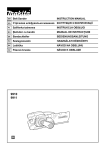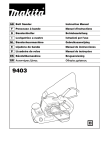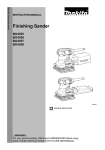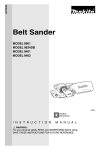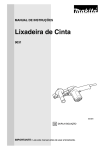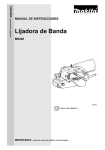Download Makita 9901 003360 Instruction manual
Transcript
ENGLISH (Original instructions) INSTRUCTION MANUAL Belt Sander 9901 9924DB 9401 9402 003360 DOUBLE INSULATION WARNING: For your personal safety, READ and UNDERSTAND before using. SAVE THESE INSTRUCTIONS FOR FUTURE REFERENCE. 1 ENGLISH SPECIFICATIONS Model 9401 Belt size 9402 100 mm x 610 mm Belt speed 9901 9924DB 76 mm x 533 mm 76 mm x 610 mm 6.3 m/s 6.6 m/s H 5.8 m/s L 5.0 m/s 5.8 m/s Overall length 374 mm 328 mm 355 mm Net weight 7.4 kg 3.3 kg 4.8 kg Safety class /II • Due to our continuing programme of research and development, the specifications herein are subject to change without notice. • Specifications may differ from country to country. • Weight according to EPTA-Procedure 01/2003 END201-5 For Model 9401 ENG102-3 Symbols Noise The typical A-weighted noise level determined according to EN60745: Sound pressure level (LpA) : 89 dB(A) Sound power level (LWA) : 100 dB(A) Uncertainty (K) : 3 dB(A) Wear ear protection The following show the symbols used for the equipment. Be sure that you understand their meaning before use. ・ Read instruction manual. ・ DOUBLE INSULATION ・ Only for EU countries Do not dispose of electric equipment together with household waste material! In observance of European Directive 2002/96/EC on waste electric and electronic equipment and its implementation in accordance with national law, electric equipment that have reached the end of their life must be collected separately and returned to an environmentally compatible recycling facility. ENG212-2 Vibration The vibration total value (tri-axial vector determined according to EN60745: Work mode : sanding metal plate Vibration emission (ah) : 2.5 m/s2 or less Uncertainty (K) : 1.5 m/s2 sum) For Model 9402 ENG102-3 Noise The typical A-weighted noise level determined according to EN60745: Sound pressure level (LpA) : 93 dB(A) Sound power level (LWA) : 104 dB(A) Uncertainty (K) : 3 dB(A) Wear ear protection ENE052-1 Intended use The tool is intended for the sanding of large surface of wood, plastic and metal materials as well as painted surfaces. ENF002-1 Power supply The tool should be connected only to a power supply of the same voltage as indicated on the nameplate, and can only be operated on single-phase AC supply. They are double-insulated in accordance with European Standard and can, therefore, also be used from sockets without earth wire. ENG212-2 Vibration The vibration total value (tri-axial vector determined according to EN60745: Work mode : sanding metal plate Vibration emission (ah) : 2.5 m/s2 or less Uncertainty (K) : 1.5 m/s2 2 sum) GEA005-3 For Model 9924DB ENG102-3 General Power Tool Safety Warnings Noise The typical A-weighted noise level determined according to EN60745: Sound pressure level (LpA) : 91 dB(A) Sound power level (LWA) : 102 dB(A) Uncertainty (K) : 3 dB(A) Wear ear protection WARNING Read all safety warnings and all instructions. Failure to follow the warnings and instructions may result in electric shock, fire and/or serious injury. ENG212-2 Vibration The vibration total value (tri-axial vector determined according to EN60745: Work mode : sanding metal plate Vibration emission (ah) : 2.5 m/s2 or less Uncertainty (K) : 1.5 m/s2 Save all warnings and instructions for future reference. sum) The term "power tool" in the warnings refers to your mains-operated (corded) power tool or battery-operated (cordless) power tool. Work area safety 1. Keep work area clean and well lit. Cluttered or dark areas invite accidents. 2. Do not operate power tools in explosive atmospheres, such as in the presence of flammable liquids, gases or dust. Power tools create sparks which may ignite the dust or fumes. 3. Keep children and bystanders away while operating a power tool. Distractions can cause you to lose control. Electrical safety 4. Power tool plugs must match the outlet. Never modify the plug in any way. Do not use any adapter plugs with earthed (grounded) power tools. Unmodified plugs and matching outlets will reduce risk of electric shock. 5. Avoid body contact with earthed or grounded surfaces such as pipes, radiators, ranges and refrigerators. There is an increased risk of electric shock if your body is earthed or grounded. 6. Do not expose power tools to rain or wet conditions. Water entering a power tool will increase the risk of electric shock. 7. Do not abuse the cord. Never use the cord for carrying, pulling or unplugging the power tool. Keep cord away from heat, oil, sharp edges or moving parts. Damaged or entangled cords increase the risk of electric shock. 8. When operating a power tool outdoors, use an extension cord suitable for outdoor use. Use of a cord suitable for outdoor use reduces the risk of electric shock. 9. If operating a power tool in a damp location is unavoidable, use a residual current device (RCD) protected supply. Use of an RCD reduces the risk of electric shock. 10. Use of power supply via a RCD with a rated residual current of 30mA or less is always recommended. ENH101-13 For European countries only EC Declaration of Conformity We Makita Corporation as the responsible manufacturer declare that the following Makita machine(s): Designation of Machine: Belt Sander Model No./ Type: 9401,9402,9924DB are of series production and Conforms to the following European Directives: 98/37/EC until 28th December 2009 and then with 2006/42/EC from 29th December 2009 And are manufactured in accordance with the following standards or standardised documents: EN60745 The technical documentation is kept by our authorised representative in Europe who is: Makita International Europe Ltd, Michigan, Drive, Tongwell, Milton Keynes, MK15 8JD, England 30th January 2009 000230 Tomoyasu Kato Director Makita Corporation 3-11-8, Sumiyoshi-cho, Anjo, Aichi, JAPAN 3 dangerous in the hands of untrained users. Maintain power tools. Check for misalignment or binding of moving parts, breakage of parts and any other condition that may affect the power tool’s operation. If damaged, have the power tool repaired before use. Many accidents are caused by poorly maintained power tools. 23. Keep cutting tools sharp and clean. Properly maintained cutting tools with sharp cutting edges are less likely to bind and are easier to control. 24. Use the power tool, accessories and tool bits etc. in accordance with these instructions, taking into account the working conditions and the work to be performed. Use of the power tool for operations different from those intended could result in a hazardous situation. Service 25. Have your power tool serviced by a qualified repair person using only identical replacement parts. This will ensure that the safety of the power tool is maintained. 26. Follow instruction for lubricating and changing accessories. 27. Keep handles dry, clean and free from oil and grease. Personal safety 11. Stay alert, watch what you are doing and use common sense when operating a power tool. Do not use a power tool while you are tired or under the influence of drugs, alcohol or medication. A moment of inattention while operating power tools may result in serious personal injury. 12. Use personal protective equipment. Always wear eye protection. Protective equipment such as dust mask, non-skid safety shoes, hard hat, or hearing protection used for appropriate conditions will reduce personal injuries. 13. Prevent unintentional starting. Ensure the switch is in the off-position before connecting to power source and/or battery pack, picking up or carrying the tool. Carrying power tools with your finger on the switch or energising power tools that have the switch on invites accidents. 14. Remove any adjusting key or wrench before turning the power tool on. A wrench or a key left attached to a rotating part of the power tool may result in personal injury. 15. Do not overreach. Keep proper footing and balance at all times. This enables better control of the power tool in unexpected situations. 16. Dress properly. Do not wear loose clothing or jewellery. Keep your hair, clothing, and gloves away from moving parts. Loose clothes, jewellery or long hair can be caught in moving parts. 17. If devices are provided for the connection of dust extraction and collection facilities, ensure these are connected and properly used. Use of dust collection can reduce dust-related hazards. Power tool use and care 18. Do not force the power tool. Use the correct power tool for your application. The correct power tool will do the job better and safer at the rate for which it was designed. 19. Do not use the power tool if the switch does not turn it on and off. Any power tool that cannot be controlled with the switch is dangerous and must be repaired. 20. Disconnect the plug from the power source and/or the battery pack from the power tool before making any adjustments, changing accessories, or storing power tools. Such preventive safety measures reduce the risk of starting the power tool accidentally. 21. Store idle power tools out of the reach of children and do not allow persons unfamiliar with the power tool or these instructions to operate the power tool. Power tools are 22. GEB015-3 BELT SANDER SAFETY WARNINGS 1. 2. 3. 4. 5. 6. 7. 8. 9. 10. 4 Hold power tool by insulated gripping surfaces, because the belt may contact its own cord. Cutting a "live" wire may make exposed metal parts of the power tool "live" and could give the operator an electric shock. Ventilate your work area adequately when you perform sanding operations. Some material contains chemicals which may be toxic. Take caution to prevent dust inhalation and skin contact. Follow material supplier safety data. Always use the correct dust mask/respirator for the material and application you are working with. Always use safety glasses or goggles. Ordinary eye or sun glasses are NOT safety glasses. Hold the tool firmly with both hands. Make sure the belt is not contacting the workpiece before the switch is turned on. Keep hands away from rotating parts. Do not leave the tool running. Operate the tool only when hand-held. This tool has not been waterproofed, so do not use water on the workpiece surface. SAVE THESE INSTRUCTIONS. To change the tool speed, press the "H" side of the speed change switch for high speed, or the "L" side for low speed. WARNING: DO NOT let comfort or familiarity with product (gained from repeated use) replace strict adherence to safety rules for the subject product. MISUSE or failure to follow the safety rules stated in this instruction manual may cause serious personal injury. • ASSEMBLY FUNCTIONAL DESCRIPTION • CAUTION: Use the speed change switch only after the tool comes to a complete stop. • CAUTION: Always be sure that the tool is switched off and unplugged before adjusting or checking function on the tool. CAUTION: Always be sure that the tool is switched off and unplugged before carrying out any work on the tool. Installing or removing abrasive belt 1. Lever Switch action 1. Lock button 2. Switch trigger 1 1 003372 2 Pull the lever all the way out and install the belt over the rollers, and then return the lever to the original position. 003365 CAUTION: Before plugging in the tool, always check to see that the switch trigger actuates properly and returns to the "OFF" position when released. To start the tool, simply pull the switch trigger. Release the switch trigger to stop. For continuous operation, pull the switch trigger and then push in the lock button. To stop the tool from the locked position, pull the switch trigger fully, and then release it. • • CAUTION: When installing the belt, make sure that the direction of the arrow on the back of the belt corresponds to the one on the tool itself. Speed change For 9402 only 003377 1. Speed change switch Adjusting belt tracking 1. Adjusting knob H 1 L 004049 1 003381 5 MAINTENANCE While the belt is running, use the adjusting knob to center the belt tracking. Failure to do so can result in frayed belt edges and wear on the sander frame. • Dust bag 1 1. Dust spout 2. Dust bag CAUTION: Always be sure that the tool is switched off and unplugged before attempting to perform inspection or maintenance. Replacing carbon brushes 2 1. Limit mark 003386 1 The use of the dust bag makes sanding operations clean and dust collection easy. To attach the dust bag, fit it onto the dust spout. When the dust bag is about half full, remove the dust bag from the tool and pull the fastener out. Empty the dust bag of its contents, tapping it lightly so as to remove particles adhering to the insides which might hamper further collection. 001145 Remove and check the carbon brushes regularly. Replace them when they are worn down to the limit mark. Keep the carbon brushes clean and free to slip in the holders. Both carbon brushes should be replaced at the same time. Use only identical carbon brushes. Use a screwdriver to remove the brush holder caps. Take out the worn carbon brushes, insert the new ones and secure the brush holder caps. OPERATION Sanding operation 1. Screwdriver 2. Brush holder cap 1 2 003397 003392 To maintain product SAFETY and RELIABILITY, repairs, any other maintenance or adjustment should be performed by Makita Authorized Service Centers, always using Makita replacement parts. CAUTION: • The tool should not be in contact with the workpiece surface when you turn the tool on or off. Otherwise a poor sanding finish or damage of the belt may result. Hold the tool firmly with both hands. Turn the tool on and wait until it attains full speed. Then gently place the tool on the workpiece surface. Keep the belt flush with the workpiece at all times and move the tool back and forth. Never force the tool. The weight of the tool applies adequate pressure. Excessive pressure may cause stalling, overheating of the motor, burning of the workpiece and possible kickback. ACCESSORIES • 6 CAUTION: These accessories or attachments are recommended for use with your Makita tool specified in this manual. The use of any other accessories or attachments might present a risk of injury to persons. Only use accessory or attachment for its stated purpose. If you need any assistance for more details regarding these accessories, ask your local Makita Service Center. • Abrasive belts • Carbon plate • Sanding shoe • Dust bag • Belt sander stand (For Model 9901,9924DB ) 7 Makita Corporation Anjo, Aichi, Japan 883836E226 8








